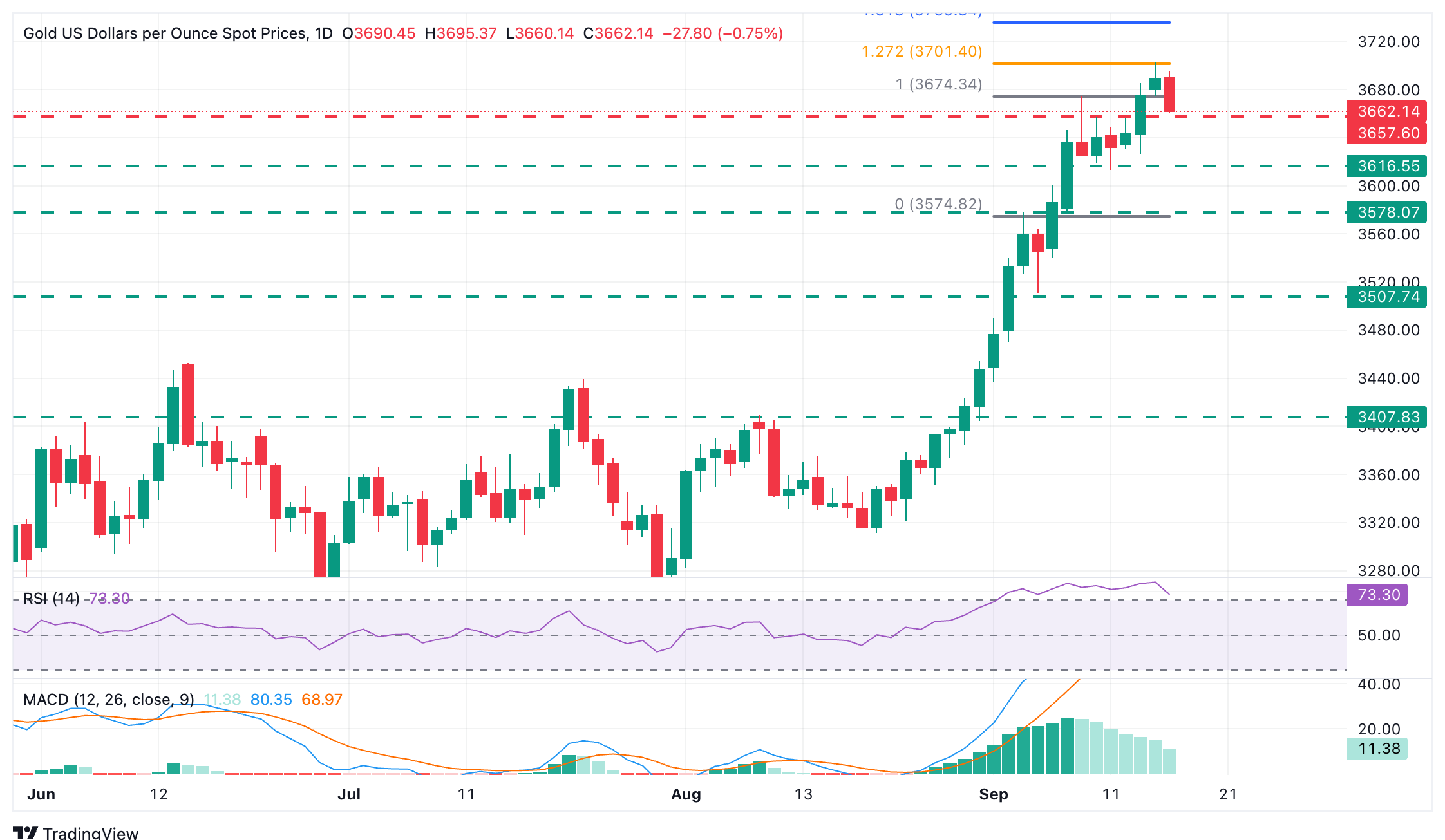Gold Price Forecast: XAU/USD drifts from record highs, $3.660 support on focus
- Gold retreats from $3,700 record highs but remains steady above $3,660 so far.
- Investors' cautiousness ahead of the Fed's decision is providing some support to the US Dollar.
- XAU/USD: A sustained break below $3,650 would give fresh hopes for bears.
Gold is trading lower on Wednesday, weighed by generalised USD strength, as investors cut short Dollar positions ahead of the Fed’s decision. The Precious metal turned lower from the $3,700 record high, with bears contained above the $3.6660 area so far.
The Federal Reserve is widely expected to cut rates by 25 basis points to the 4.0%-4.25% range, but traders are growing wary that the bank’s stance may disappoint the market’s dovish expectations. Such an outcome would snap the risk rally and fuel a deeper USD recovery.
Weak US employment data has boosted hopes of Fed cuts over the following months. Futures markets are broadly pricing a quarter point in each monetary policy meeting this year and some more in the first months of 2026, a view that is highly unlikely to be confirmed by Fed Chair Jerome Powell.
Technical Analysis: Gold has reached heavily overbought levels

XAU/USD appreciated by about 2% in the last three days and beyond 11% in the last four weeks. Technical indicators reveal an overstretched condition, particularly visible on the daily chart (in the image), which should act as a warning for buyers.
The pair has not given any clear signal of a bearish correction, but a confirmation below the $3.660-3,650 support area, which encloses the highs of September 10,11, and 12, would form an evening star candle pattern, a standard signal of trend shifts.
Further down, the September 11 low, at $3,615, would come to the focus, ahead of the September 3 high and September 8 low, at $3,580. To the upside, immediate resistance is at $3,700 level ahead of the 161.8% extension of last week’s rally, near $3,740.
Gold FAQs
Gold has played a key role in human’s history as it has been widely used as a store of value and medium of exchange. Currently, apart from its shine and usage for jewelry, the precious metal is widely seen as a safe-haven asset, meaning that it is considered a good investment during turbulent times. Gold is also widely seen as a hedge against inflation and against depreciating currencies as it doesn’t rely on any specific issuer or government.
Central banks are the biggest Gold holders. In their aim to support their currencies in turbulent times, central banks tend to diversify their reserves and buy Gold to improve the perceived strength of the economy and the currency. High Gold reserves can be a source of trust for a country’s solvency. Central banks added 1,136 tonnes of Gold worth around $70 billion to their reserves in 2022, according to data from the World Gold Council. This is the highest yearly purchase since records began. Central banks from emerging economies such as China, India and Turkey are quickly increasing their Gold reserves.
Gold has an inverse correlation with the US Dollar and US Treasuries, which are both major reserve and safe-haven assets. When the Dollar depreciates, Gold tends to rise, enabling investors and central banks to diversify their assets in turbulent times. Gold is also inversely correlated with risk assets. A rally in the stock market tends to weaken Gold price, while sell-offs in riskier markets tend to favor the precious metal.
The price can move due to a wide range of factors. Geopolitical instability or fears of a deep recession can quickly make Gold price escalate due to its safe-haven status. As a yield-less asset, Gold tends to rise with lower interest rates, while higher cost of money usually weighs down on the yellow metal. Still, most moves depend on how the US Dollar (USD) behaves as the asset is priced in dollars (XAU/USD). A strong Dollar tends to keep the price of Gold controlled, whereas a weaker Dollar is likely to push Gold prices up.

